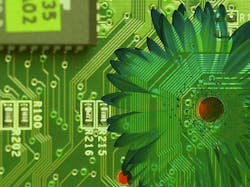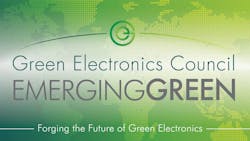Jeff started his career as an engineer in the computer industry in Silicon Valley and held a variety of product development and manufacturing management roles. Jeff received a B.S. in Industrial Engineering from Montana State. He later received an M.S. in Management Systems Engineering from Stanford University on an executive fellowship in the Honors Co-op Program.
Here is his recent interview with Electronic Design's Technology Editor Maria Guerra:
What design segments and products are being most impacted by the move toward green electronics?
Omelchuck: The move toward green electronics has helped some segments more than others. The poster child for market impact was the EU’s adoption of RoHS, which drove a massive market shift to lead-free solder. Similarly, public concern about the environmental and public health impacts of halogenated flame retardants has reduced demand for those additives. This spawned new research and presented market opportunities for alternatives. While some manufacturers struggled with the change, several very good alternatives have emerged, and those companies are thriving by the move toward green electronics. Another success story is greater use of recycled plastics in electronics. This increased demand for post-consumer recycled plastics has enabled more investment in collection and processing, creating opportunity for some and keeping more plastic out of landfills and incinerators.
What current standards are in place to force compliance to greener designs?
Omelchuck: Certainly some regulations exist, but the beauty of most environmental standards is that they’re voluntary—only customer demand “forces compliance” to them. The ENERGY STAR program, for instance, is often perceived as a requirement in the United States, but its specifications are completely optional. Fortunately, manufacturers have adopted those energy-saving attributes so widely that engineers and designers have created thousands more energy-efficient products. Likewise, the EPEAT green-rating system managed by the Green Electronics Council is a voluntary mechanism that thousands of public and private entities around the world use to guide their purchase of environmentally preferable electronics. Although EPEAT isn’t a legal requirement, it has influenced many manufacturers to design products that meet dozens of environmental attributes that their customers demand.
What standards are in the works and what impact will they have?
Omelchuck: Dozens of groups around the world work hard to develop new environmental and electronics standards every day. Where the Green Electronics Council is most engaged is the convergence of those two: environmental leadership standards for electronics. Even within this niche, at least four different processes are actively underway: creating environmental leadership standards for servers, mobile phones, and photovoltaic cells; and updating the Computer/Display standard that kick-started the successful EPEAT program. These standards are all still in process, so it’s hard to determine their exact impact. During the past decade, the purchase of electronics designed with environmental leadership standards in mind has reduced greenhouse gas emissions equivalent to taking nearly 15 million passenger cars off the road for a year, and eliminated more than 467,000 metric tons of hazardous waste. We hope this pace of environmental progress will quicken in the next decade, perhaps reaching a point where environmental innovation surpasses technical innovation.
Are there certain applications that are adopting green technologies earlier?
Omelchuck: The electronics sector finds itself at an interesting inflection point. Designers and engineers are exploring new materials that may have a reduced impact, they’re tackling water-scarcity issues, and their move toward miniaturization seems to lend itself to reducing waste. Yet parts of the current electronics-recycling infrastructure are struggling to accommodate these rapid changes, and the forecasted increase in the global middle class could lead to significant environmental challenges if the prevailing “take, make, dispose” business model doesn’t change. Some manufacturers have found ways to close the loop with their electronics—recycling plastic from an older device and using it in a new device, for example. That’s a powerful development, and we strongly encourage others to explore and adopt it.
How does the U.S. compare to the rest of the world in terms of green engineering efforts?
Omelchuck: U.S. companies and individuals are among the global leaders in green chemistry and engineering. This year GEC is partnering with Design Chain Associates to organize an electronics symposium in June at the 20th annual Green Chemistry and Engineering Conference in Portland, Ore. This will showcase how leaders throughout the electronics supply chain are applying the principles of green chemistry to make their products inherently benign. And because today’s electronics industry is a truly global affair, these green-engineering advances driven by Western market preference for greener products end up improving human health and the environment around the world.
Circular Economy was the main focal area for the 2015 Green Electronics Council Catalyst Award. What are the biggest challenges for circular economy in the electronic industry?
Omelchuck: Two areas stand out as particularly challenging for electronics in the circular economy. First, for most battery-powered electronics, the majority of the product’s life-cycle environmental impact happens during manufacturing. These impacts often come in the form of energy and indirect materials used throughout highly engineered manufacturing processes in a global supply chain. Little of this “embedded” material and energy is physically contained in the product, so it can’t be recovered at the end of a product’s life. Unlike a soda bottle, you can’t easily make new phones by grinding up old phones, for example. This value is just lost when the product is destroyed, so the best thing to do is to use the product a long time to amortize the impact of manufacturing over a longer use-life.
The second challenge is the increasing rate of consumption of these devices, driven by increasing population, increasing affluence, and shorter product lifespans. For societies worldwide, two key questions are: “How many devices do we really need to build each year to support 7 billion people?” and “Where do we get the resources to build them?” For the global electronics industry, the challenge is to design products that can and will be used longer, thus reducing resource impacts, while meeting manufacturers’ needs for growth and profitability.
What is the focal area for the 2016 Green Electronics Council Catalyst Award?
Omelchuck: The 2016 Catalyst Award will recognize “innovations in resource reduction.” Essentially, we’re looking to reward innovative products or initiatives that have decreased their resource intensity through the reduction of weight, volume, toxicity or the use of materials with high environmental loadings. There are many ways nominees may have accomplished this goal, be it through improvements in design, production, use, reuse, and/or recycling. We’re excited to see who submits a nomination, to read about their innovative solutions, and to recognize those accomplishments that will inspire and catalyze ongoing environmental leadership throughout the lifecycle of electronic technologies. We’d invite your readers to submit a nomination here if any of their initiatives may qualify.
What green educational resources are the GEC offering to the electronic industry?
Omelchuck: The Green Electronics Council offers a few primers to Design for Environment issues such as metal recyclability, as well as research prepared during the development of environmental leadership standards for servers and photovoltaic cells. In addition, manufacturers who choose to register their products in EPEAT have access to online training modules for each of the system’s underlying environmental criteria. We also offer a host of green-procurement tools, including plug-and-play model contract language, for institutions and businesses interested in adding green-electronics purchasing to their list of environmentally preferable practices.
How is GEC spreading the word worldwide? How big is the problem of electronic waste at this point?
Omelchuck: Few people question the reasons for designing and purchasing greener electronics. The global community of stakeholders, from manufacturers and suppliers to procurement teams and environmental groups, seems to know “why.” The ongoing challenge is determining “how” best to do it so each group feels satisfied. We’ve focused for a decade on bringing together diverse groups to discuss the most effective ways to achieve their shared vision. The Green Electronics Council has presented at hundreds of events worldwide, hosted the Emerging Green Conference in 2015, launched the Catalyst Awards program to recognize innovative leaders in electronics, and been stewards of the EPEAT green-rating system since 2006. Stakeholders’ dedication to EPEAT alone has delivered significant environmental benefits. Yet according to UN University, nearly 42 million metric tons of e-waste was shipped in 2014 to developing countries. There’s still work to be done to collaborate on solutions that dramatically reduce the amount and impact of e-waste. We’re honored to have stakeholders’ trust in identifying—with them—how best to tackle that challenge.
About the Author
Maria Guerra
Power/Analog Editor
Maria Guerra is the Power/Analog Editor for Electronic Design. She is an Electrical Engineer with an MSEE from NYU Tandon School of Engineering. She has a very solid engineering background and extensive experience with technical documentation and writing. Before joining Electronic Design, she was an Electrical Engineer for Kellogg, Brown & Root Ltd (London. U.K.). During her years in the Oil and Gas Industry she was involved in a range of projects for both offshore and onshore designs. Her technical and soft skills bring a practical, hands-on approach to the Electronic Design team.


